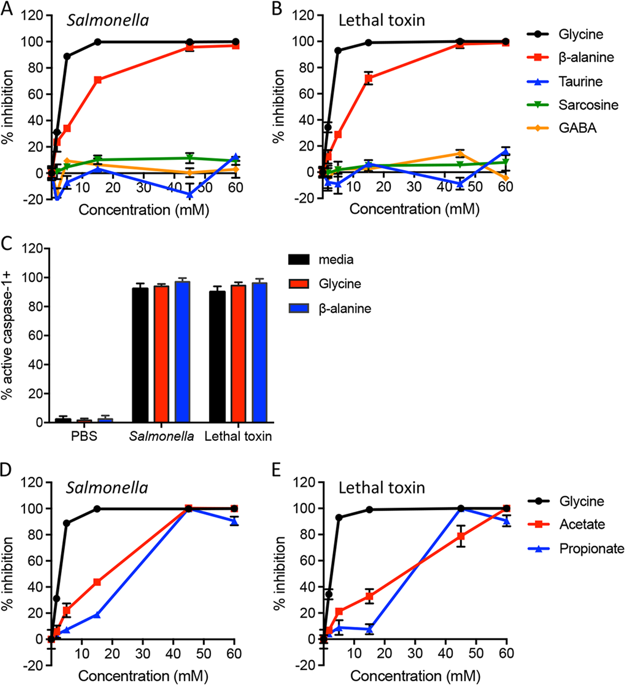当前位置:
X-MOL 学术
›
Cell Death Dis.
›
论文详情
Our official English website, www.x-mol.net, welcomes your
feedback! (Note: you will need to create a separate account there.)
Diverse small molecules prevent macrophage lysis during pyroptosis.
Cell Death & Disease ( IF 8.1 ) Pub Date : 2019-04-11 , DOI: 10.1038/s41419-019-1559-4 Wendy P Loomis 1 , Andreas B den Hartigh 1 , Brad T Cookson 1, 2 , Susan L Fink 1
Cell Death & Disease ( IF 8.1 ) Pub Date : 2019-04-11 , DOI: 10.1038/s41419-019-1559-4 Wendy P Loomis 1 , Andreas B den Hartigh 1 , Brad T Cookson 1, 2 , Susan L Fink 1
Affiliation

|
Pyroptosis is a programmed process of proinflammatory cell death mediated by caspase-1-related proteases that cleave the pore-forming protein, gasdermin D, causing cell lysis and release of inflammatory intracellular contents. The amino acid glycine prevents pyroptotic lysis via unknown mechanisms, without affecting caspase-1 activation or pore formation. Pyroptosis plays a critical role in diverse inflammatory diseases, including sepsis. Septic lethality is prevented by glycine treatment, suggesting that glycine-mediated cytoprotection may provide therapeutic benefit. In this study, we systematically examined a panel of small molecules, structurally related to glycine, for their ability to prevent pyroptotic lysis. We found a requirement for the carboxyl group, and limited tolerance for larger amino groups and substitution of the hydrogen R group. Glycine is an agonist for the neuronal glycine receptor, which acts as a ligand-gated chloride channel. The array of cytoprotective small molecules we identified resembles that of known glycine receptor modulators. However, using genetically deficient Glrb mutant macrophages, we found that the glycine receptor is not required for pyroptotic cytoprotection. Furthermore, protection against pyroptotic lysis is independent of extracellular chloride conductance, arguing against an effect mediated by ligand-gated chloride channels. Finally, we conducted a small-scale, hypothesis-driven small-molecule screen and identified unexpected ion channel modulators that prevent pyroptotic lysis with increased potency compared to glycine. Together, these findings demonstrate that pyroptotic lysis can be pharmacologically modulated and pave the way toward identification of therapeutic strategies for pathologic conditions associated with pyroptosis.
中文翻译:

多样化的小分子可防止细胞凋亡过程中的巨噬细胞裂解。
细胞凋亡是由caspase-1相关蛋白酶介导的促炎性细胞死亡的程序化过程,其裂解成孔蛋白gasdermin D,引起细胞裂解并释放炎性细胞内内容物。氨基酸甘氨酸可通过未知机制阻止焦磷酸裂解,而不会影响caspase-1的激活或孔的形成。细胞凋亡在包括败血症在内的多种炎性疾病中起着至关重要的作用。甘氨酸处理可防止败血症致死性,这表明甘氨酸介导的细胞保护作用可能会提供治疗益处。在这项研究中,我们系统地检查了一组与甘氨酸在结构上相关的小分子,它们具有防止焦磷酸解的能力。我们发现了对羧基的要求,以及对较大氨基和氢R基团取代的有限耐受性。甘氨酸是神经元甘氨酸受体的激动剂,其充当配体门控的氯离子通道。我们鉴定出的细胞保护性小分子阵列类似于已知的甘氨酸受体调节剂。但是,使用遗传缺陷的Glrb突变巨噬细胞,我们发现甘氨酸受体并不是焦磷酸化细胞保护所必需的。此外,针对热解裂解的保护独立于细胞外氯化物电导,认为是由配体门控的氯化物通道介导的作用。最后,我们进行了小规模的,假设驱动的小分子筛选,并确定了意想不到的离子通道调节剂,与甘氨酸相比,这些离子通道调节剂可防止热解裂解,并具有更高的效能。一起,
更新日期:2019-04-11
中文翻译:

多样化的小分子可防止细胞凋亡过程中的巨噬细胞裂解。
细胞凋亡是由caspase-1相关蛋白酶介导的促炎性细胞死亡的程序化过程,其裂解成孔蛋白gasdermin D,引起细胞裂解并释放炎性细胞内内容物。氨基酸甘氨酸可通过未知机制阻止焦磷酸裂解,而不会影响caspase-1的激活或孔的形成。细胞凋亡在包括败血症在内的多种炎性疾病中起着至关重要的作用。甘氨酸处理可防止败血症致死性,这表明甘氨酸介导的细胞保护作用可能会提供治疗益处。在这项研究中,我们系统地检查了一组与甘氨酸在结构上相关的小分子,它们具有防止焦磷酸解的能力。我们发现了对羧基的要求,以及对较大氨基和氢R基团取代的有限耐受性。甘氨酸是神经元甘氨酸受体的激动剂,其充当配体门控的氯离子通道。我们鉴定出的细胞保护性小分子阵列类似于已知的甘氨酸受体调节剂。但是,使用遗传缺陷的Glrb突变巨噬细胞,我们发现甘氨酸受体并不是焦磷酸化细胞保护所必需的。此外,针对热解裂解的保护独立于细胞外氯化物电导,认为是由配体门控的氯化物通道介导的作用。最后,我们进行了小规模的,假设驱动的小分子筛选,并确定了意想不到的离子通道调节剂,与甘氨酸相比,这些离子通道调节剂可防止热解裂解,并具有更高的效能。一起,

















































 京公网安备 11010802027423号
京公网安备 11010802027423号